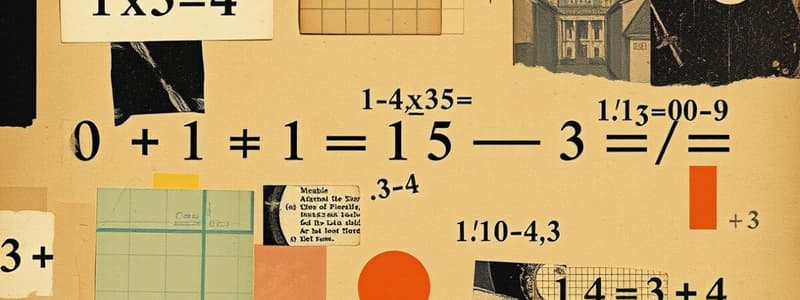Podcast
Questions and Answers
Find the sum: $\frac{x-2}{x^2+1} + \frac{x+3}{x^2+1}$
Find the sum: $\frac{x-2}{x^2+1} + \frac{x+3}{x^2+1}$
- x + 1
- 2x + 1
- x
- 2x + 1/x^2 + 1 (correct)
Find the difference:
Find the difference:
- x + 4
- 0
- 9/x - 1 (correct)
- 5/x + 2
Enter the values for a and b that complete the sum: a = _______ b = _______
Enter the values for a and b that complete the sum: a = _______ b = _______
3, 5
Enter the values for m, n, and p that complete the difference: m = _______ n = _______ p = _______
Enter the values for m, n, and p that complete the difference: m = _______ n = _______ p = _______
Enter the values for the highlighted variables to complete the steps to find the sum: a = _____ b = _____ c = _____ d = _____ e = _____ f = _____ g = _____
Enter the values for the highlighted variables to complete the steps to find the sum: a = _____ b = _____ c = _____ d = _____ e = _____ f = _____ g = _____
Enter the values for the highlighted variables that show how to subtract the rational expressions correctly: a = _____ b = _____ c = _____ d = _____ e = _____ f = _____ g = _____
Enter the values for the highlighted variables that show how to subtract the rational expressions correctly: a = _____ b = _____ c = _____ d = _____ e = _____ f = _____ g = _____
Find the sum: $\frac{6}{x-4} + \frac{5}{x}$
Find the sum: $\frac{6}{x-4} + \frac{5}{x}$
Find the difference:
Find the difference:
Which solution shown below contains an error?
Which solution shown below contains an error?
Perform the indicated operations:
Perform the indicated operations:
Which expression is equivalent to $\frac{3}{x} - 2 - \frac{5}{2} - \frac{4}{x} - 2$?
Which expression is equivalent to $\frac{3}{x} - 2 - \frac{5}{2} - \frac{4}{x} - 2$?
Describe the error made in subtracting the two rational expressions shown:
Describe the error made in subtracting the two rational expressions shown:
Explain the steps involved in adding two rational expressions.
Explain the steps involved in adding two rational expressions.
Flashcards
Adding Rational Expressions
Adding Rational Expressions
Finding the sum of two or more rational expressions requires a common denominator.
Subtracting Rational Expressions
Subtracting Rational Expressions
Similar to adding, subtract rational expressions by finding a common denominator.
Common Denominator
Common Denominator
Essential for adding/subtracting rational expressions, like fractions.
Factoring Denominators
Factoring Denominators
Signup and view all the flashcards
Simplifying Expressions
Simplifying Expressions
Signup and view all the flashcards
Combining Numerators
Combining Numerators
Signup and view all the flashcards
Rational Expression
Rational Expression
Signup and view all the flashcards
Error Identification
Error Identification
Signup and view all the flashcards
Practice Problems
Practice Problems
Signup and view all the flashcards
Equivalent Expressions
Equivalent Expressions
Signup and view all the flashcards
Mistake in Subtracting
Mistake in Subtracting
Signup and view all the flashcards
Steps to add Rational Expressions
Steps to add Rational Expressions
Signup and view all the flashcards
Value of a
Value of a
Signup and view all the flashcards
Study Notes
Adding and Subtracting Rational Expressions
- To find the sum of rational expressions, ensure common denominators are used.
- Example: The sum of (x-2)/(x^2+1) and (x+3)/(x^2+1) results in (2x+1)/(x^2+1).
Difference of Rational Expressions
- The difference of two expressions involves similar steps as the sum.
- Example result for the difference is 9/(x-1).
Values for Sum and Difference
- Key components for completing the sum are defined as:
- a = 3
- b = 5
- Important values for completing the difference are:
- m = 3
- n = 14
- p = 2
Summation Variables
- Highlighted variables for a specific summation:
- a = -1
- b = -9
- c = 9
- d = 3
- e = 3
- f = 2
- g = 1.5
Subtraction of Rational Expressions
- Variables important for correctly subtracting rational expressions are:
- a = 6
- b = 2
- c = 6
- d = 2
- e = 6
- f = 6
- g = 1
Practice Problems
- Finding the sum of rational expressions, e.g., the sum of 6/(x-4) and 5/x results in (11x-20)/(x^2-4).
- The difference can yield an expression such as -x-22/((x+10)(x+4)).
Identifying Errors
- Errors can occur in processes; for example, recognizing an incorrect solution in given options helps in learning.
- An observed mistake involved miscalculating the sum where the expression 1/(x+2) was misinterpreted as 1/(x+1).
Performing Operations on Rational Expressions
- Indicating operations can lead to simplified forms, e.g., (x+1)/(x+9) being one of the potential outcomes.
Equivalent Expressions
- Understanding equivalency in expressions is essential; for instance, the expression (3/x - 2 - 5/2 - 4/x - 2) can simplify to (13-5x)/(2x-8).
Common Mistakes in Operations
- Mistakes in subtracting rational expressions often arise from the factoring process, such as yielding incorrect denominators or not properly combining numerators.
Steps for Adding Rational Expressions
- When adding rational expressions:
- Identify a common denominator.
- Factor the denominators.
- Adjust numerators accordingly, then simplify and combine the numerators last.
Studying That Suits You
Use AI to generate personalized quizzes and flashcards to suit your learning preferences.




